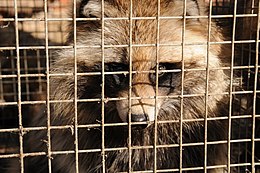This article is written like a personal reflection, personal essay, or argumentative essay that states a Wikipedia editor's personal feelings or presents an original argument about a topic. (June 2023) |

| Part of a series on |
| Clothing and the environment |
|---|
| Environmental impact of fashion |
Fur farming is the process of breeding animals in captivity for the sake of harvesting their fur to be sold primarily for clothing purposes. Fur is no longer primarily obtained through animal trapping; most fur comes from farms, where animals are raised to be killed for their fur. Fur farming operations provide about 80 percent of overall fur production.[1] Common sources of fur include mink, raccoon, and fox.[2] Up to 30 million mink furs are produced annually in North America and Europe.[3] The production of pelts involves large-scale tanning and disposal of animal carcasses after they are skinned. Fur production reportedly impacts the environment negatively through the release of gases, chemicals and fossil fuels.
Some conservationists say that fur farming could have a positive environmental impact, reducing the pressure of wild-animal population growth. According to fur-farming advocates, it relies on sustainable resources which can be recycled. Fur industrialists call their practices agriculturally "green" compared with the production of fake fur, because they are enhancing a natural product instead of creating a new one; faux-fur fibers, produced with non-sustainable resources, have a negative environmental impact.[4]
- ^ "Toxic Fur: The Impacts of Fur Production on the Environment and the Risks to Human Health" (PDF). humanesociety.org. January 29, 2009. Archived (PDF) from the original on May 7, 2019. Retrieved August 25, 2020.
- ^ Ramchandani, Mukta; Coste-Mainiere, Ivan (2017). "To Fur or Not to Fur: Sustainable Production and Consumption Within Animal-Based Luxury and Fashion Based Products". www.springer.com. Archived from the original on April 7, 2019. Retrieved March 3, 2019.
- ^ Mason, Georgia; Cooper, Johnathan; Clarebrough, Catherine (March 1, 2001). "Frustrations of fur-farmed mink". Nature. 410 (6824). International Journal of Science: 35–36. doi:10.1038/35065157. PMID 11242031. S2CID 39542739. Archived from the original on April 14, 2019. Retrieved April 13, 2019.
- ^ Bijleveld, Marijn; Korteland, Marisa; Sevenster, Maartje (January 2011). "The Environmental Impact of Mink Fur Production". www.cedeflt.eu. CE Delft. Archived from the original on April 7, 2019. Retrieved March 1, 2019.
